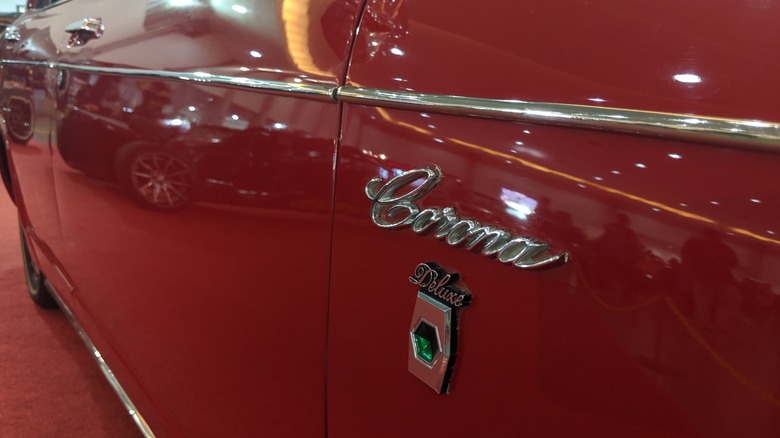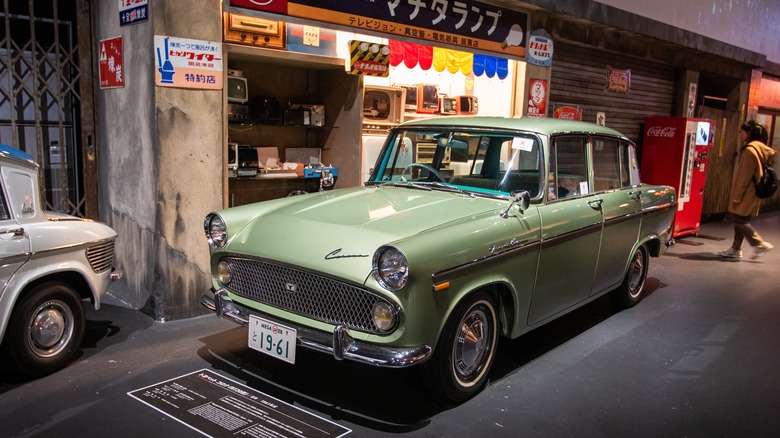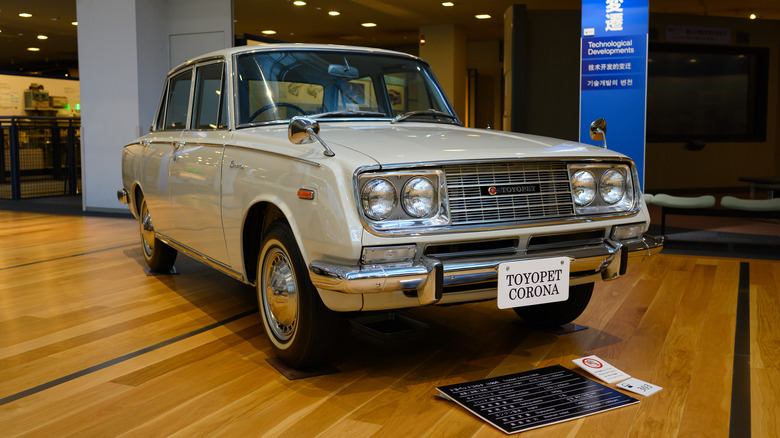How The Toyota Corona Changed The Course Of History For Toyota In The USA
Toyota's are as pervasive in the United States today as apple pie and, well ... Chevrolet. NASCAR is about as American as you can get, yet the Japanese automaker is one of only three other manufacturers (along with Chevrolet and Ford) currently running on the acclaimed stock car racing circuit — with great success.
As recently as July 2024, Toyota vehicles accounted for three of the top 11 best-selling cars in America so far (RAV4 at #3, Camry at #7, and Corolla at #11), with the Camry claiming the title as the top-selling passenger car in the U.S. In 2021, Toyota Motor Corporation finally jumped ahead of General Motors for the first time to become the top-selling car company in the U.S.
All that prestige started when Toyota introduced hundreds of the Toyopet Crown four-door sedan (and one lone Land Cruiser) to the American market in 1958. While the Crown looked very much like a miniature version of other luxury American cars of the day, Toyota failed to consider U.S. roads and highways when designing the vehicle. In fact, the Crown lacked power (top speed was a mere 75 mph), was unstable and vibrated at high speeds, parts broke, and interior noise was off the charts.
All of these problems, combined with a higher price tag, made sales a certified disaster. That didn't deter Toyota, though, because it came back with a redesigned vehicle in 1964 called the Corona (meaning "crown" in Latin).
If at first you don't succeed ...
Today, the word "Corona" more likely triggers thoughts of the Pandemic or the Mexican beer, but between April 1965 and December 1967, it was known for being Japan's best-selling car. Toyota's goal with the Corona was to make a quality vehicle bigger and roomier than the Volkswagen Type 1 — and it delivered. While it's considered one of the best cars Toyota's ever designed today, it hit a few speed bumps in getting there.
That first Japanese iteration had a 95.3-inch wheelbase with a nose-to-trunk length of about 162 inches. Under the hood of the 2,000-pound, unibody, rear-wheel-drive car was a 70 horsepower (1,500cc) four-cylinder engine. Although the four-door sub-compact sedan hit the streets first, a two-door hardtop coupe with the same specs wasn't far behind.
When Toyota brought the Corona stateside in '65, it had better performance and was explicitly redesigned for American roads. Now sitting under a hood that tilted forward was a longitudinally-mounted OHV four-cylinder engine that produced 90 horsepower (1,900cc) with a downdraft two-barrel carburetor. When strapped with a three-speed manual gearbox, this new engine pushed the Corona to a top speed of 95 mph. If paired with the two-speed "Toyoglide" column-shifting automatic transmission (based on GM's Powerglide), its top speed dropped to 90 mph.
The Corona was replete with all the interior bells and whistles, too: bench seats, sun visors (with vanity mirrors), tinted glass, bar speedometer, two-speed windshield wipers, a glove compartment, a radio, and factory-installed air conditioning — unusual for a small import at the time.
The Corona led to Toyota's runaway success
Toyota had learned from its mistakes with the Crown by building a car for American roads, and buyers took notice because it became its first car to sell over 10,000 units in the United States. In fact, sales of the Corona (one of Toyota's first models to get exported globally) bolstered the company's sales in the U.S. So much so that in 1966 (threefold, to over 20,000 units by Toyota's account), that by the following year, the Japanese automaker was the third-best-selling import brand in America.
Interestingly, the Corona was featured in Toyota's first television commercial in North America. A few years later (1969), Road Test anointed it as the Import Car of the Year, and some 45 years later (2014), Car and Driver declared the Corona one of the best cars Toyota ever made. Not bad for a car that failed spectacularly in the U.S. the first time, proving how tenacious and driven the Toyota Motor Corporation was in succeeding.
The Corona was the bridge that allowed Toyota to usher in the Corolla — perhaps one of the most successful models in Toyota history — to the U.S. market in 1968. Combined, it sold 72,554 vehicles that year; over 124,000 units in 1969; and north of 200,000 sold the following year. Meanwhile, the Corolla is now considered the world's best-selling passenger car of all time, with over 50 million sold in more than 140 countries. Perhaps neither would have reached such lofty heights if Toyota hadn't adapted and improvised with the Corona.


